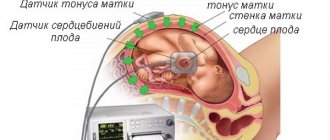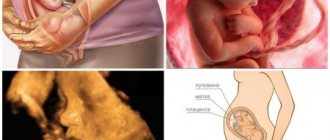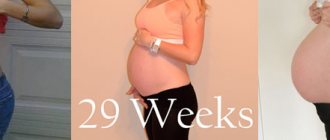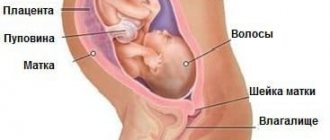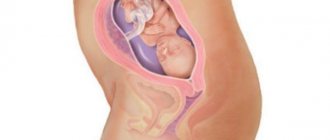How's the baby doing?
The physiological parameters of the baby’s body at this stage largely depend on genetic characteristics and hereditary factors. In most cases, in the last weeks of pregnancy, which exceeds 40 weeks, the baby is already quite large, reaching the weight and height of a newborn child. Average body weight corresponds to 3-3.8 kg, height - 50-54 cm. If there are complications of pregnancy that affect the development of the baby, he may be born low-weight (less than 2.8 kg) or large (more than 3.8 kg). Exceeding the norm is often observed with gestational diabetes, obesity in the mother, low weight is sometimes detected with gestosis, uteroplacental insufficiency. Increasingly, large children are born, weighing 4–5 kg, without health problems.
Now the intrauterine baby looks like a newborn
At 40–41 weeks, the development of the intrauterine baby is completed, the organs and systems are formed, and it is ready to be born. We list other changes in the development of the baby:
- nails grow longer than the nail bed;
- hair on the head can be thick or sparse, it depends on genetic factors;
- subcutaneous fat accumulates;
- maturation of the nervous system continues, which will continue after birth;
- well developed innate reflexes - sucking, swallowing and others;
- the skeleton becomes strong, the skull bones retain some mobility - this is necessary for movement along the birth canal;
- the baby is cramped in the womb, movements may become less frequent, but are felt by the mother more clearly than before;
- the chin, arms and legs are pressed tightly to the body;
- the adrenal glands, endocrine and immune systems function;
- a sufficient amount of surfactant has accumulated in the lungs, necessary for the full opening of the alveoli and full breathing outside the womb;
- the baby’s intestines are sterile, but are already working, colonization with intestinal microflora will occur after birth;
- Meconium, the original feces, accumulates in the colon;
- the contours of the body acquire infantile roundness, facial features like those of a newborn;
- vision is developed enough to see a clear picture at a distance of up to 20 cm;
- The cartilage of the ears and nose became denser and became more elastic.
Post-term pregnancy
You can no longer wait to reach the logical conclusion of your pregnancy, and the lack of harbingers of labor causes concern. In fact, at 40–41 weeks the pregnancy is not yet considered post-term. Only at the full 40 obstetric weeks does the preliminary date of birth occur, and the baby can normally be born in a few more days. Often, childbirth is “delayed” due to incorrect determination of the gestational age.
At 40–41 weeks, pregnancy is not yet considered post-term
Doctors consider a pregnancy to be post-term if it continues more than 10–14 days after the preliminary date of birth. In this case, the baby may be born with signs of overmaturity:
- wrinkled skin without cheese-like lubricant;
- greenish skin tone;
- long nails and hair;
- too dense skull bones;
- narrow fontanel and spaces between unfused bones of the skull.
A sign of overripeness is also a green or yellow tint of amniotic fluid (normally light, translucent), which also indicates hypoxia (oxygen starvation) of the fetus. It is not the fact of postmaturity itself that has negative consequences for the future health of the baby, but the problems that he experienced in the womb. Thus, with chronic hypoxia and uteroplacental insufficiency, disturbances in the activity of the nervous system often occur, and the baby requires the supervision of a neurologist. If birth occurs at 40–41 weeks, in most cases, this is normal and negative consequences for the child are unlikely.
Many studies indicate that the diagnosis of “post-term pregnancy” is not always correct, since it is almost impossible to accurately determine the day of birth. Determining the duration of pregnancy and the date of birth is difficult due to the fact that it is difficult to establish the exact date of ovulation - the release of the egg from the ovary, the time of fertilization, the speed of sperm movement, the life cycle of the egg and many other features of the woman’s body. Therefore, childbirth is considered timely at 37-42 weeks.
Prolonged (translated from Latin - extended) is a pregnancy that lasts longer than usual by 10-14 days (290-294 days) and ends with the birth of a full-term, functionally mature child without signs of post-maturity. The frequency of biological post-term pregnancy is 2% of the total number of births.
A pregnancy that lasts more than 10–14 days after the expected due date (290–294 days) is considered truly post-term. The child is born with signs of overmaturity. This type of pregnancy occurs in 4% of women giving birth.
Irina Matevosyan Obstetrician-gynecologist, Ph.D. honey. Sciences, Assistant, Department of Obstetrics and Gynecology, St. Petersburg State Pediatric Medical Academy
https://www.9months.ru/beremennostbase/3148/perenoshennaya-beremennost
Position in the uterus
The normal position of the fetus in the uterus is head down (cephalic presentation). This position is optimal for childbirth and facilitates movement along the birth canal. In the last weeks of pregnancy, the baby's head gradually descends into the upper birth canal. Due to the pressure placed on the cervix, the organ dilates in preparation for childbirth. However, it may happen that before birth the baby remains in the breech (breech) position - legs down. Transverse presentation (oblique) is also possible, although it is extremely rare, because then the fetus is very cramped.
The position of the fetus can be determined by ultrasound
In most cases, with pelvic, transverse presentation, doctors decide on the need for a cesarean section, but natural childbirth is not excluded. The baby may roll over until the onset of labor, but with each week of pregnancy this probability decreases.
What happens in the mother's body
In the last weeks of pregnancy, the mother experiences fatigue - both physical and emotional. The fetus already weighs a lot, and the belly is too large and causes discomfort. The woman’s body weight has also increased significantly - the normal increase is about 8–12 kg.
Most likely, the baby took a head down position
Now you may also notice the following sensations:
- the uterus drops lower, pressure on the bladder increases, which leads to increased urination, even to the point of incontinence;
- insomnia occurs due to increased anxiety before childbirth;
- training contractions become more frequent—sometimes the uterus “turns to stone” and the stomach tightens;
- Vaginal discharge may change - become liquid (amniotic fluid leaks) or yellow, gray mucus with blood spots appears (the plug comes off);
- fetal movements have become less frequent, but more noticeable than before;
- shortness of breath appears even with little physical activity (the uterus supports the diaphragm of the lungs, and the heart experiences a heavy load);
- colostrum leaks from the breast - the mammary glands are preparing to feed the newborn;
- swelling of the limbs and face increases;
- lower back pain caused by a shift in the center of gravity of the spine;
- pain in the perineum due to bones moving apart before childbirth;
- stretch marks, chloasma (pigment spots).
Photo gallery: bellies at 40–41 weeks
When your belly drops, you will notice external and internal changes. Take pictures of yourself as a souvenir of your pregnancy.
At 41 weeks the belly reaches its maximum size.
Many mothers are already expecting hospital birth at 41 weeks
Harbingers of childbirth
The mucus plug may come off completely or come out in fragments
Symptoms characteristic of the onset of labor are usually called precursors. Let's list these signs:
- Abdominal prolapse. With a cephalic presentation, the baby's skull descends into the upper birth canal, and the stomach drops. This is noticeable not only externally, but also in sensations - it becomes easier to breathe, the intensity of heartburn decreases. But the load on the bladder increases, which leads to frequent visits to the restroom.
- Discharge of water. If labor has not yet begun, amniotic fluid may only leak. Normally it is light and translucent. If the water has a green tint or bloody discharge appears, you should immediately consult a doctor. Complete rupture of water is a signal of the onset of labor; you must immediately arrive at the maternity hospital.
- Contractions. Previously, you were worried about training contractions. They manifested themselves as short-term contractions of the uterus, disappeared on their own when changing body position, and did not appear periodically, no more than 4–5 times per hour. True contractions are regular, and the intervals are no more than 10–15 minutes. In this case, intense pain is felt in the lower abdomen, radiating to the lower back. When this condition occurs, the onset of labor can be established.
- Discharge of mucus plug. This substance protects the cervix from infections and mechanical damage. Shortly before birth, she clears the way for the fetus to come out. A mucous lump of pink, yellow, white color with streaks of blood can come out completely right before the amniotic fluid is released, or it can be released little by little over 1-2 weeks before birth.
- Weight loss. This is usually how the body gets rid of excess fluid before giving birth. You may notice that your weight has decreased by 1-2 kg in a short period of time. At the same time, the frequency of urination increases, diarrhea and nausea may occur.
Precursors may appear in the later stages, several days before the onset of labor or immediately before the onset of the “x” hour. The main signs of rapidly beginning labor: rupture of amniotic fluid and regular contractions (more than 5 per hour) . It is known that women who give birth repeatedly notice the warning signs earlier, and the interval between their appearance and childbirth is shorter than in first-time mothers. This is partly due to the fact that these sensations are already familiar to them, they will not confuse them with anything. The body is also familiar with these changes, so it reacts faster to hormonal signals, and labor occurs earlier.
If contractions begin, interspersed with uniform and gradually shortening intervals, the mother and baby feel well, no water has been poured out - we go to the maternity hospital no later than a 10-minute interval between contractions. If the contractions that begin are irregular, the mother and baby feel well, no water has been poured out - we rest and wait for further developments. If any amount of water comes out or is leaking, or there is even a suspicion that water has broken, we go to the maternity hospital immediately. In doubtful cases, a special test will be performed in the emergency room of the maternity hospital - a smear for water. The result will be ready in 15–30 minutes and will allow you to confirm or refute the fact of rupture of the amniotic sac, regardless of its size and location.
Elizaveta Novoselova Obstetrician-gynecologist, Moscow
https://www.9months.ru/rodybase/3367/nachalo-rodov
Pregnancy 39 - 40 weeks
When pregnancy reaches 39 weeks, it is already difficult for the child to be in the womb. After all, the baby has already filled the entire uterine cavity and has nowhere to turn around, in addition, it is also dark there. The child wants to quickly get out into the wild to take a breath of fresh air and look around.
It is precisely because your baby is already trying to get out into the world that unusual sensations appear at 39 - 40 weeks of pregnancy. This may indicate impending birth. It’s just that already at this stage the baby sinks lower and lower into the pelvis, as a result of which the fundus of the uterus also drops, it becomes softer. Typically, the following symptoms may appear in the prenatal days:
- bleeding from the genital tract;
- slight weight loss;
- stools are a little looser than usual;
- increased appetite;
- the appearance of the “nesting” instinct, which manifests the woman’s emotional mood and she begins to equip a “nest” for the baby.
Of course, these symptoms are not always an accurate signal for the onset of labor, but still, at such a late stage you should be very vigilant.
Baby movements during pregnancy at 39 - 40 weeks
For the first time, the baby makes itself known somewhere around 20-22 weeks. He is active throughout the entire period, sometimes more, sometimes less. The baby turns over, moves his legs and arms, hiccups, yawns and breathes. Mom can feel all this. But closer to the fortieth week, the baby begins to show his emotionality a little less, because there is not enough space for “play”. He barely has enough space to get comfortable and wait for the onset of labor.
Usually, at this stage, the baby begins to sleep with his mother, and not indulge, as it was before: you do everything around the house, walk on the street, watch TV - he sits like a mouse, but as soon as he lies down and closes his eyes, the playful little girl wakes up with a playful appetite and he somersaults in his stomach as soon as he wants.
The normal number of fetal movements after 32 weeks of pregnancy is considered to be at least ten over six hours. If you observe the baby’s activity for twelve hours, then their number should be at least 24. If the baby has become too calm and it is impossible to count the required number of movements, then you should consult a doctor.
Discharge at 39 - 40 weeks of pregnancy
Typically, throughout pregnancy, vaginal discharge is profuse, sometimes white and thick. The norm is considered to be those that do not have an unpleasant odor and an unusual color: yellowish, slightly green, brown or cream. The appearance of “colored” discharge is always a beacon of infectious diseases that need to be treated urgently.
But when discharge mixed with blood appears already at 39 or 40 weeks, then there is no need to worry. this means it’s time to collect all the necessary supplies and be ready for the trip to the maternity hospital. Sometimes, before the appearance of such discharge, training contractions may appear a couple of weeks before the appearance of such discharge, which prepare the uterus for childbirth.
BUT REMEMBER! If contractions occur at intervals of 5-10 minutes, then this is no longer training, but real childbirth and there is no need to waste time. You need to call an ambulance to take you to the hospital. There is no need to rush too much, because the birth process is not as fast as it seems.
End of 39 weeks of pregnancy
So, if your pregnancy has passed the 39th week, then you should be prepared for the fact that at the beginning of the 40th week you should already give birth. Sometimes such an event may be a little late, and the baby will be born at 41 weeks. But still, the main path has already been passed and there is little time left before you see your little angel.
| Fetal weight by week of pregnancy Fetal weight is an indicator that week after week indicates the development of the child in the mother's womb. That’s why the numbers obtained from measurements are so important - although they are approximate, growth dynamics can tell a lot. | Menstruation in the first month of pregnancy At the beginning of pregnancy, there is often spotting, which women mistake for menstruation. How normal is this phenomenon, and what dangers may be hidden under it - we will try to answer these questions. |
| 18th week of pregnancy - fetal development For expectant mothers, the 18th week is a kind of new stage in her pregnancy - many note the awakening of maternal feelings precisely with the beginning of movements, and the attitude towards the baby becomes more reverent. | Pregnancy 21 weeks - fetal development At the 21st week of pregnancy, the baby has already crossed the “equator” of its development, and now its goal is to grow and become stronger in order to be well prepared for birth. |
Don't know what to wear? Become fashionable immediately! Your name * Email address * Other articles: Placenta during pregnancy A woman’s amazing body creates a placenta during pregnancy, which feeds her unborn child and protects her from the troubles of the outside world. But what dangers threaten the placenta itself? How should the placenta develop correctly during pregnancy and how should it not? Answers in our article. Amniotic fluid index Amniotic fluid is also called amniotic fluid. For a normal pregnancy, their number must be normal. Quantity indicators are determined by such an indicator as the amniotic fluid index. In our article, read about the norm of amniotic fluid and such phenomena as oligohydramnios and polyhydramnios. 35 weeks of pregnancy - movements Not only expectant mothers and fathers, but also those around them love to watch a child tossing and turning towards his stomach. Of course, it’s so funny to see how the big belly shakes. But at 35 weeks of pregnancy, the frequency of such movements decreases significantly.
If labor begins
Having felt contractions at home, you can quickly prepare for a trip to the hospital. Take a shower, shave your crotch with a regular razor, trim your nails. Place the necessary documents in your bag:
- exchange card;
- birth certificate;
- passport;
- medical insurance;
- SNILS.
Already in the maternity hospital, if the waters have not broken and the contractions are true, the doctors will open the amniotic sac. If labor began not with contractions, but with the rupture of water (often observed during repeated pregnancy), it is prohibited:
- delay in arriving at the maternity hospital;
- carry out hygiene procedures;
- Eating;
- stay indoors.
You must immediately call an ambulance or go to the maternity hospital in a personal vehicle with an accompanying driver.
If there are signs of labor beginning, you must come to the maternity hospital
Jumping on a fitball (large ball), walking, massage of the lower abdomen and back, standing on all fours, and a warm shower will help ease the condition during contractions. A special breathing technique is relevant during contractions: at the peak of the contraction, inhale slowly and deeply through your nose, and then exhale through your mouth. If the grips become more frequent, breathing, on the contrary, should become frequent and shallow.
Postures in the first stage of labor - when the cervix dilates - are quite varied. They can be divided into vertical, horizontal - lying on your side, as well as poses using a fitball - a large inflatable gymnastic ball, widely used in maternity hospitals to facilitate contractions and pushing.
It must be remembered that if childbirth proceeds without complications, then the choice of comfortable positions remains entirely up to the woman in labor: she can behave freely during childbirth. If there are deviations during labor, the obstetrician-gynecologist leading the birth will give recommendations on what body position is advisable to take so as not to harm the woman in labor or the baby.
Nina Abzalova Obstetrician-gynecologist, Ph.D. honey. Sciences, Altai State Medical University, Barnaul
https://www.9months.ru/podgotovka/4436/vstante-v-pozu
What not to do:
- Eat. It is possible that general anesthesia will be required during childbirth (in case of emergency caesarean section). If there is food in the stomach, there is a high probability of the contents being thrown into the mouth and lungs, which will lead to pneumonia. During natural childbirth, vomiting may begin during contractions, because there is a reflex connection between the cervix and the stomach.
- Sit. When the baby's head has already dropped into the birth canal, sitting on a hard surface puts unwanted pressure on the skull. This is especially true for multiparous women and rapid labor. When sitting on a fitball or toilet, such a negative effect is not observed.
- Take painkillers. Uncontrolled use of anesthetic drugs is extremely undesirable. They will not stop labor, but will help other important symptoms go unnoticed.
- Lie on your back. In this position, the uterus compresses the vena cava, which leads to increased blood pressure, circulatory disorders, and fainting. If you need to take a lying position to perform a CTG (cardiotocogram) of the fetus in the maternity hospital, lie on your side.
Woman's well-being
At the 41st week of expecting a baby, the expectant mother is overcome not only by worries, but also by severe physical discomfort associated with the large size of the abdomen and the pressure of the fetus on the organs, venous and arterial vessels, and nerve formations of the pelvis. This is manifested by the following symptoms:
- Various pain sensations. The back, lower back, legs, stomach, perineum hurt. The nature of the pain can be aching, shooting, pressing, cramping.
- Frequent urination and urine leakage with any straining.
- Edema of the lower extremities.
- Stool disorder. Some pregnant women have a tendency to diarrhea, while others continue to experience constipation.
- Numbness of hands and feet.
- Insomnia.
- Itching of the skin of the anterior abdominal wall.
To improve her well-being, the expectant mother should rest as much as possible and do things that are pleasant to the soul. Now is not the time for cleaning, washing, or shopping.
Induction of labor
Only a doctor can make a decision about inducing labor after examining the patient and the fetus. If the mother feels normal, and the fetus in the womb does not experience oxygen starvation, there are no other complications, there is no need to interfere with this natural process. Medical methods of inducing labor are required in situations where the waters have broken, and contractions are too rare or absent at all, the cervix is not dilated, etc. The need to artificially induce natural birth or perform a cesarean section occurs with fetal hypoxia, a large fetus, hardening of the skull bones and other complications. In this case, medications or mechanical effects, droppers with oxytocin, opening of the amniotic sac and other manipulations performed by specialists are used. When choosing means of influence, the expectant mother’s medical history, the nuances of the course of pregnancy and many other factors are taken into account.
Recent Entries
Is it possible to give a mirror: how to protect yourself from bad omens It became known about the influence of cell phone towers on human health Is it possible to eat bananas bought in Russia?
Only doctors can induce labor with medications.
Oxytocin is a hormone with a complex protein structure that is produced in the brain and acts mainly on the uterus, contracting it. This occurs due to the fact that a large number of oxytocin receptors are located in the uterus. During pregnancy, the number of receptors increases and their sensitivity to oxytocin increases. There are few receptors for oxytocin in other organs and tissues of the female body, therefore, this drug acts selectively, which helps to avoid many side effects.
Anna Kalenova Obstetrician-gynecologist, St. Petersburg
https://www.9months.ru/rodybase/5873/stimulyaciya-oksitocinom-kogda-ona-neobhodima-i-byvayut-li-oslozhneniya
Some mothers can’t wait to meet their baby or are afraid of the baby being “post-term” or induced in the hospital; they try in every possible way to speed up the birth on their own. Even if you decide to use safe folk methods of stimulating labor, consult your doctor so as not to harm yourself and your baby. We list the acceptable methods of self-stimulation of labor:
- Physical activity. Walking in the fresh air will enrich the body with fresh air and tone it, bringing birth closer. It is not forbidden to clean the house and do household chores without overworking yourself.
- Sex. The so-called “husband therapy” is an effective way to induce labor. Sperm contains hormones that soften the cervix, and during orgasm, the uterus contracts, which can lead to contractions.
- Breast massage. Stimulation of the mammary glands in the nipple area provokes increased production of the hormone oxytocin, which is responsible for breastfeeding and causes uterine contractions.
- Herbal remedies. A strong infusion of raspberry leaves, flaxseed oil, and a mixture of sparkling water, apricot, almond and castor oil are known to stimulate labor.
- Special food. It is known about the relationship between intestinal motility and the onset of labor. By stimulating digestion, you can promote childbirth. Increase your consumption of fiber-rich vegetables, prunes, and dairy products.
- Aromatherapy. It is believed that the scent of jasmine and rose can help speed up labor. Use the aroma lamp and oils of these plants for unobtrusive inhalations.
An effective non-drug way to soften the cervix is regular sex (starting from the 36th week of pregnancy). The fact is that male sperm contains prostaglandins, which are so necessary for preparing for childbirth, which help the cervix to “ripe”. It is this method that is primarily “prescribed” by gynecologists to the expectant mother in the last stages of pregnancy, if examination of the cervix shows that it is not yet “ripe”. Of course, this method can only be recommended in the absence of contraindications, for example, the threat of premature birth and placenta previa.
Isabella Charchyan Obstetrician-gynecologist, Moscow
https://www.9months.ru/podgotovka/5452/skoro-rozhat-gotov-li-organizm-k-rodam-i-chto-delat-esli-net
What not to do
Hot water treatments - baths, saunas, baths can trigger labor. However, they increase blood circulation, which can cause increased blood pressure, dizziness and other undesirable conditions.
A visit to the bathhouse can not only provoke labor, but also worsen your health
Self-administered acupuncture sessions can also cause harm. According to this teaching, there are points on the body that are responsible for the activity of one or another organ. Accordingly, if you apply a needle to the areas responsible for uterine contractions, you can stimulate labor. Inept use of this method can lead to a deterioration in health and even harm the baby.
Excessive physical exertion to speed up labor can also have negative consequences. Lifting heavy objects and sudden movements can lead to placental abruption, and injuries and falls as a result of careless actions can even lead to the death of the fetus.
Advice for expectant mothers
The main advice for this week: do not ignore going to the antenatal clinic and, if the doctor says that it is better to be hospitalized, pack your things and go to the maternity hospital. It is, of course, more pleasant to wait for the birth at home, but now, when the situation can change at any moment and there is a tendency to carry the pregnancy to term, it is better to be under round-the-clock supervision of medical personnel.
At this stage, it is advisable for the expectant mother to undergo daily cardiotocography (CTG), which allows her to accurately assess the baby’s condition, be regularly examined using an ultrasound machine, and also take blood and urine tests. All this is much more convenient to do in a hospital.
Zubkova Olga Sergeevna, medical observer, epidemiologist
6, total, today
( 193 votes, average: 4.61 out of 5)
Beer while breastfeeding: how long does it take for it to leave the body?
How to treat colds during pregnancy: rules of treatment in each trimester
Related Posts
Reviews from mothers about ways to induce labor
One way to speed up labor is to take a good walk through rough terrain—through a forest park, for example. (by the way, I started to feel strange after a long walk along the shore of the pond, and 3 days later I gave birth). Another way is lots and lots of laughter. Jokes aside, but disappearance over a long period of time usually provokes labor within 24 hours; I know many such cases.
Hyena
https://deti.mail.ru/forum/v_ozhidanii_chuda/rody/kak_vyzvat_rody_estestvennym_putem/
Sex, sex and more sex!!!! and not just there, little by little, but with all the passion you can muster. and believe me, you will remember these minutes for a long time after giving birth, since there will be neither time nor energy for this... (and God forbid stitches) They also wanted to admit me to the maternity hospital for stimulation, but I told the doctor I won’t give up without a fight)) ) came home and loved my husband all day and all night. At 10:00 the next day, contractions began. 10 hours later she gave birth.
MISS ALEKSEEVA
https://deti.mail.ru/forum/v_ozhidanii_chuda/rody/kak_vyzvat_rody_estestvennym_putem/
I’ve heard about hard labor - it causes the uterus to contract, and before that it also cleanses the intestines, so you can immediately cleanse and get contractions from two tablespoons of castor oil.
Katya Capn
https://deti.mail.ru/forum/v_ozhidanii_chuda/rody/kak_vyzvat_rody_estestvennym_putem/?page=2
Live an active sex life - that's it! Sperm contains substances that soften the cervix. The second way is to climb the stairs. The doctor recommended it to me herself. The uterus really comes into tone, but if the cervix is not ready, this will not help.
Evgeniya
https://deti.mail.ru/forum/v_ozhidanii_chuda/rody/kak_vyzvat_rody_estestvennym_putem/?page=2
I was advised to imitate the movements as if you were mopping the floors from side to side. I tried it and contractions started within a couple of hours. Although the day before the neck was not ready yet. I don’t know if it was a coincidence or if it helped, but in the end I gave birth on my own after the first CS
Magic
https://www.woman.ru/health/Pregnancy/thread/3859111/
Scatter the matches and bend down for each one separately. only if the time has not come, why do you and your child need it? I gave birth 3 days ahead of schedule after actively cleaning the kitchen cabinets, especially the lower ones. True, inducing the onset of labor was not part of my plans.
hell
https://www.woman.ru/health/Pregnancy/thread/3859111/
no way to induce labor
